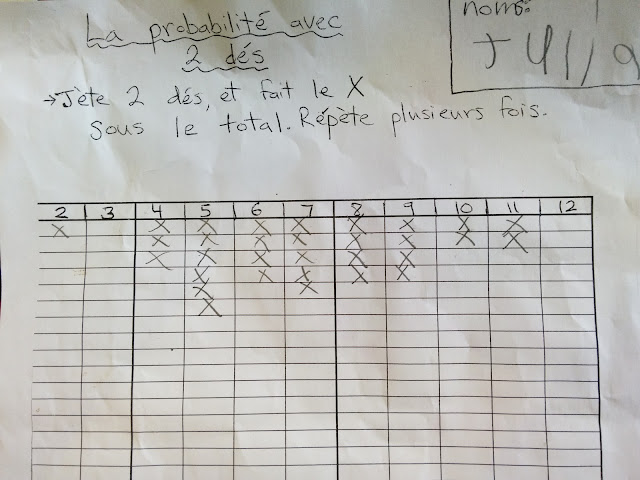In math, we spent the week exploring probability. After learning the vocabulary (the French words for impossible, improbable, equally likely, likely and certain) we talked about and illustrated a range of future events in terms of their probability. The kids loved coming up with impossible scenarios, like that a dinosaur would walk into our classroom! Then the kids experienced 3 activities in which they recorded with tally marks how many times a given outcome occurred. For each activity I asked them to predict if the stated outcome was improbable, equally likely or likely. They flipped a 2-sided counter (like flipping a coin) and recorded which colour came up each time (equally likely). They rolled a pair of dice and recorded how often they got doubles vs. non-doubles (doubles being unlikely). And they tossed a coin onto a hundred chart, and recorded how often it landed on a 2-digit number vs. a non-2-digit number (2-digit number being likely). Then we talked about our results and our predictions, and came to the idea that more possibilities for something (like more ways to roll non-doubles or more 2-digit numbers on the hundred chart) made it more probable.
I reviewed our probability vocabulary again mid-week, by showing 5 trays of coloured tiles. I asked, if I closed my eyes, how likely was I to pick a blue tile from each tray? The kids matched the probability word with the corresponding tray.
Our next experiment was with rolling 2 dice, adding the 2 numbers together, and marking that sum on a chart. Everyone gathered data on their own and we compiled everyone's results. The kids were surprised to see a pattern in the graph of the dice sums!
As you know, I sent these images home and asked you parents to talk over with your kids why the middle numbers were more likely to be rolled than the smallest and largest numbers. We had a lively discussion on the following Monday - thanks for all the convos at home!
We began our unit on the Local Community this week. I began with building the vocabulary we need. We read a book that follows someone's journey from the country, through farmland and small towns, and eventually to a big city. We talked about the difference between cities, towns and the country. Then I posted a bunch of labelled images of the things we find on city streets: schools, stores, parks, supermarkets...Each child chose one to illustrate with collage.
We played a game to consolidate the vocabulary, where kids paired up to have the following conversation:
- "Yesterday I went/Today I am going/Tomorrow I will go...to the _____________(one of the places in cities)."
- "Oh, really?"
- "Yes, really!" OR "No, not really!"
After each conversation the kids thanked each other and went off to find another conversation partner. They really enjoyed the element of trickery!
Then we talked about maps and how they show the view from the sky. To bring that concept home, the kids filled in an outline of their classroom, creating a map with all the furniture and carpets in their proper spots.
All this lead up prepared them for our field trip to Kensington Market! The kids were divided into 4 groups, and each group had a map with a route marked on it and 3 locations to visit. These were things like a bank, a bakery, a fire station...etc. Each group visited a different trio of locations, and their task was to photograph (with an iPad) each location.
We reassembled in the Kensington parkette, and each group showed their pictures and talked about their route to the class (kids were pretty distracted because they all wanted to play in the playground!). Then we had a great time playing in the park before returning to school. Thank you to the volunteers who made the trip possible!
We reassembled in the Kensington parkette, and each group showed their pictures and talked about their route to the class (kids were pretty distracted because they all wanted to play in the playground!). Then we had a great time playing in the park before returning to school. Thank you to the volunteers who made the trip possible!


















No comments:
Post a Comment